PROPOSED RULEMAKING
ENVIRONMENTAL QUALITY BOARD
[ 25 PA. CODE CH. 250 ]
Administration of the Land Recycling Program
[54 Pa.B. 3937]
[Saturday, July 13, 2024]The Environmental Quality Board (Board) proposes to amend Chapter 250 (relating to administration of land recycling program). This rulemaking is proposed under § 250.11 (relating to periodic review of MSCs), which requires that the Department of Environmental Protection (Department) review new scientific information that relates to the basis of the Statewide health standard medium-specific concentrations (MSC) at least 36 months after the effective date of the most recently promulgated MSCs and propose to the Board any changes to the MSCs as necessary. In addition to updating the existing MSCs, this proposed rulemaking would update the models used to calculate the soil lead MSCs and update the Department's process for calculating MSCs for carcinogenic polycyclic aromatic hydrocarbons (PAH). This proposed rulemaking would also clarify several other regulatory requirements.
This proposed rulemaking was adopted by the Board at its meeting of March 12, 2024.
A. Effective Date
This proposed rulemaking will be effective upon final-form publication in the Pennsylvania Bulletin.
B. Contact Persons
For further information contact Michael Maddigan, Program Manager, Land Recycling Program, P.O. Box 8471, Rachel Carson State Office Building, Harrisburg, PA 17105-8471, (717) 772-3609, or Lindsay Williamson, Assistant Counsel, Bureau of Regulatory Counsel, P.O. Box 8464, Rachel Carson State Office Building, Harrisburg, PA 17105-8464, (717) 783-9372. Information regarding submitting comments on this proposal appears in Section J of this preamble. Persons with a disability may use the Pennsylvania Hamilton Relay Service by calling (800) 654-5984 (TDD users) or (800) 654-5988 (voice users). This proposed rulemaking is available on the Department's web site at www.dep.pa.gov (select ''Public Participation,'' then ''Environmental Quality Board,'' then navigate to the Board meeting of March 12, 2024).
C. Statutory Authority
This proposed rulemaking is authorized under sections 104(a) and 303(a) of the Land Recycling and Environmental Remediation Standards Act (Act 2) (35 P.S. §§ 6026.104(a) and 6026.303(a)) and section 1920-A of The Administrative Code of 1929 (71 P.S. § 510-20). Section 104(a) of Act 2 authorizes the Board to adopt Statewide health standards as well as appropriate mathematically valid statistical tests to define compliance with Act 2 and other regulations that may be needed to implement the provisions of Act 2. Section 303(a) of Act 2 authorizes the Board to promulgate Statewide health standards for regulated substances for each environmental medium and methods used to calculate the standards. Section 1920-A of The Administrative Code of 1929 authorizes the Board to formulate, adopt and promulgate rules and regulations that are necessary for the proper work of the Department.
D. Background and Purpose
Section 250.11 of the land recycling program's regulations requires that the Department review new scientific information that is used to calculate MSCs under the Statewide health standard and propose appropriate changes at least every 36 months following the effective date of the most recently promulgated MSCs. The Board's most recently promulgated MSCs became effective upon publication in the Pennsylvania Bulletin at 51 Pa.B. 7173 (November 20, 2021). These proposed changes, based on new information, protect public health and the environment and provide the regulated community with clear information regarding the requirements of Act 2 and Chapter 250 related to the remediation of contaminated sites.
The proposed amendments include changes to soil numeric values for 46 regulated substances; 45% of these changes lower the current values and the other 55% increase those values. Changes to groundwater numeric values are proposed for 34 regulated substances; half of these changes lower the current values and the other half increase those values. In addition to updating the Chapter 250 MSCs, this proposed rulemaking includes changes that would add groundwater and soil MSCs for five compounds in the per- and polyfluoroalkyl substances (PFAS) family (hexafluoropropylene oxide (HFPO) dimer acid, HFPO dimer acid ammonium salt (Gen-X), perfluorobutanoic acid (PFBA), perfluorohexanoic acid (PFHxA), and perfluorobutane sulfonate (PFBS) potassium salt) and update the values for three others (PFBS, perfluorooctane sulfonate (PFOS), and perfluorooctanoic acid (PFOA)). The proposed standards for these PFAS are based on data in toxicological studies published by the Department's Bureau of Safe Drinking Water or the United States Environmental Protection Agency (EPA). Under section 303(a) of Act 2, the Department has directly incorporated the EPA's Health Advisory Levels (HAL) regarding PFBS and HFPO dimer acid and their salts as groundwater MSCs and has used the data developed by the EPA for those HALs to calculate soil MSCs for both compounds. The Department has also directly incorporated the Bureau of Safe Drinking Water's published Maximum Contaminant Level (MCL) values regarding PFOA and PFOS as groundwater MSCs, and has used the toxicological data developed by the Bureau of Safe Drinking Water for those MCLs to calculate soil MSCs for both compounds. With respect to PFHxA and PFBA, the Department is proposing soil and groundwater standards based on 2023 EPA Integrated Risk Information System (IRIS) evaluations.
This proposed rulemaking includes changes to the methods for calculating the direct contact soil standards for lead. The previous rulemaking finalized in 2021 that updated the MSCs also had proposed changes to the direct contact numeric values. The Board received many comments on the lead standards during that public comment period. Most of the commentators expressed concern with the proposed increase in the nonresidential direct contact numeric value for lead in surface soil in Table 4A (relating to medium-specific concentrations (MSCs) for inorganic regulated substances in soil—direct contact numeric values). The main concern expressed by the public comments was the proposed use of 10 micrograms per deciliter (µg/dL) as the target blood lead level (TBLL).
The number and nature of the public comments received on this issue prompted the Department to publish an Advance Notice of Proposed Rulemaking (ANPR) in the Pennsylvania Bulletin at 51 Pa.B. 6776 (October 30, 2021) to solicit information necessary to prepare this proposed rulemaking. Specifically, the Department requested information which could be used to evaluate: (1) the proposed updates to the lead models used to calculate the soil lead MSCs; (2) the potential changes to model input parameters; and (3) the potential changes to the statistical tests used to demonstrate attainment of the Statewide health standard for lead in soil at Act 2 remediation sites. During the submission period for the ANPR, the Department received comments from two individuals and one organization that were considered during the development of this proposed rulemaking.
This proposed rulemaking includes the updated models published by the EPA, which are the Integrated Exposure Uptake Biokinetic (IEUBK) Model for Children that will be used to calculate the residential values and the Adult Lead Model (ALM) that will be used to calculate the nonresidential values. In addition to updating the models, the TBLL is proposed to be reduced from the current values of 10 µg/dL for residential calculations and 20 µg/dL for nonresidential calculations to 5 µg/dL for both residential and nonresidential calculations, which is the default value used in the EPA models.
Additionally, this proposed rulemaking includes a change in the method of determining the toxicity values for six carcinogenic polycyclic aromatic hydrocarbon (PAH) compounds (Benzo[a]anthracene, Benzo[b]fluoranthene, Benzo[k]fluoranthene, Chrysene, Dibenz[a,h]anthracene and Indeno[1,2,3-c,d]pyrene). The EPA's guidance recommends the application of relative potency factors (RPF) to assess the carcinogenic hazard from oral exposure to carcinogenic PAHs. RPFs are comparative risk estimates of the relative potency of each carcinogenic PAH as compared to benzo[a]pyrene (BaP). BaP is a commonly found PAH that has a significantly higher number of documented toxicity studies than the other six PAHs. When the EPA updated the toxicity value for BaP in IRIS in January 2017, the supporting documents specifically referred to the EPA's 1993 guidance document on the use of RPFs for determining the toxicity of six other PAH compounds. The Board proposes to use the EPA's RPFs as toxicity values to more accurately calculate MSCs for these six carcinogenic PAHs.
Furthermore, this proposed rulemaking will update the method for determining MSCs for 19 compounds by choosing subchronic (short-term exposure) toxicity values over chronic (long-term exposure) toxicity values. The EPA's Office of Land and Emergency Management (OLEM) issued a memo in May 2021 (Recommendations on the Use of Chronic or Subchronic Noncancer Values for Superfund Human Health Risk Assessments, https://semspub.epa.gov/src/document/HQ/100002839) regarding the use of certain toxicity values based on recommendations from OLEM's Human Health Regional Risk Assessment Forum's Toxicity Workgroup. The OLEM's memo recommends using subchronic toxicity values in place of chronic toxicity values to more accurately represent the risk of exposure to certain compounds. The Department typically selects chronic toxicity values for calculating numeric values used to determine the MSCs, so using the process recommended in the OLEM's memo changes the Department's toxicity value selection procedure for 19 compounds.
The EPA also provided guidance to the Department regarding the use of certain values from the EPA's Health Effect Assessment Summary Tables (HEAST) database. The HEAST database has not been updated since 1997 and as IRIS and Provisional Peer-Reviewed Toxicity Values (PPRTV) published values, any HEAST values for those same compounds were rescinded by the EPA. It has been clarified through direct communication with the EPA that any compounds evaluated within IRIS and PPRTV that specifically state that a value could not be calculated are also considered to be rescinded. Therefore, several HEAST toxicity values are proposed to be removed from Tables 5A and 5B (relating to physical and toxicological properties—organic regulated substances; and physical and toxicological properties—inorganic regulated substances) in this proposed rulemaking.
Finally, this proposed rulemaking would clarify a procedural issue related to the administrative requirements of Act 2 by specifying that MCLs and HALs become effective as MSCs upon publication of the final MCL or HAL by the EPA or the Department.
This proposed rulemaking impacts any person addressing a release of a regulated substance at a property, whether voluntarily or as a result of an order by the Department. This proposed rulemaking would not impact any particular category of person with additional or new regulatory obligations. Under Act 2, a remediator may select the standard to which to remediate. To complete a remediation, the remediator shall then comply with all relevant remediation and administrative standards.
As noted previously, this proposed rulemaking will not singularly affect one specific industry or person. This proposed rulemaking will impact the owners and operators of storage tank facilities that have had a release of petroleum or a hazardous substance. There are approximately 12,000 storage facilities in this Commonwealth. Some of these facilities are owned or operated by small businesses. Because of the broad potential reach of this proposed rulemaking, it is not possible to identify specific types and numbers of small businesses that could potentially be affected by property contamination. In addition, Act 2 and Chapter 250 are unique from other statutes and regulations because they do not create permitting or corrective action obligations. Instead, Act 2 and Chapter 250 provide remediators with options to address contamination and any associated liability that arises under other statutes. For example, adding PFBA to Chapter 250 does not create any liability or obligation related to PFBA. Instead, a person's liability arises under The Clean Streams Law (35 P.S. §§ 691.1—691.1001), while Act 2 and Chapter 250 provide that person the means to resolve their Clean Streams Law liability and address the contamination. In this way, Act 2 and Chapter 250 do not create new obligations that will impact a particular category of person like a new permitting obligation or corrective action regulation would.
This rulemaking proposes to adjust the cleanup thresholds for demonstration of the Statewide health standard. Lowering the values may indicate a more stringent cleanup is required at a site and increasing the values may indicate a less stringent cleanup is required at a site. The soil numeric values represent a proposed decrease in approximately 45% of the values and an increase in 55% of the values. For groundwater, the proposed changes reflect a decrease in approximately 50% of the values and an increase in approximately 50% of the values. These proposed changes reflect updated information related to exposure limitations to these substances and recognize that a higher or lower standard is better representative of those substances' exposure thresholds.
The number of completed remediations varies each year. On average, remediators apply the Act 2 remediation standard to just under 300 contaminated properties across this Commonwealth per year. Generally, the cost related to a given site remediation depends in large part on which regulated substances are being remediated and what the specific soil and groundwater conditions are at the site.
The Department worked with the Cleanup Standards Scientific Advisory Board (CSSAB) during the development of this proposed rulemaking. The CSSAB was established by section 105 of Act 2 (35 P.S. § 6026.105) and consists of persons representing a cross-section of experience, including engineering, biology, hydrogeology, statistics, medicine, chemistry, toxicology and other related fields. The purpose of the CSSAB is to assist the Department and the Board in developing Statewide health standards, determining the appropriate statistically and scientifically valid procedures and risk factors to be used, and providing other technical advice as needed to implement Act 2. During CSSAB meetings on October 20, 2022, January 23, 2023, and May 31, 2023, CSSAB members had the opportunity to review and provide feedback on draft regulatory amendments to Chapter 250.
The Department worked with the CSSAB to resolve their concerns. Following these presentations and discussions, the CSSAB voted on January 23, 2023, in support of the Department's recommendation to move the regulation forward to the Board for consideration. After making additional updates to the draft regulation to address the HEAST values changes and add the PFAS compound PFHxA, the CSSAB reviewed and affirmed their decision to support the Department on May 31, 2023.
E. Summary of Regulatory Requirements
§ 250.304. MSCs for groundwater.
In subsection (c), this proposed rulemaking would clarify that MCLs and HALs are effective immediately upon publication in either the Federal Register or the Pennsylvania Bulletin.
In subsection (g), this proposed rulemaking would add a source of aqueous solubility information for PFAS to support the new compounds proposed to be added to the MSC tables in this rulemaking.
§ 250.305. MSCs for soil.
In subsection (b), the proposed amendments clarify the mathematical operation taking place by including multiplication symbols in the equations, updating the associated variable definitions and adding a missing definition.
§ 250.306. Ingestion numeric values.
In subsection (d), this proposed rulemaking would correct a typographical error for the groundwater ingestion factor.
The proposed amendments to subsection (e) would update the models used to calculate the residential and nonresidential ingestion numeric values for lead in soil. This includes changes to the TBLLs that are applied to the corresponding lead numeric value calculations. The models currently used by the Department are the Uptake Biokinetic (UBK) and Society for Environmental Geochemistry and Health (SEGH) models, which are outdated and need to be replaced with more current science. The Board is proposing to replace these models with the EPA's most up-to-date IEUBK model and the EPA's ALM. These model updates also include reducing the current TBLLs from 10 µg/dL in children (UBK model) and 20 µg/dL in adults (SEGH model) to 5 µg/dL for both models because 5 µg/dL is the default TBLL used in the IEUBK and ALM models. The receptor in both models is children; the IEUBK model receptor is children from zero to 84 months of age and the ALM receptor is a fetus in the womb of an exposed adult. The IEUBK and ALM models were developed by the EPA's Superfund Program and their use, including their default values, ensures that the Commonwealth's environmental cleanup program incorporates the most up-to-date science associated with the EPA's environmental cleanup program. The Department's Land Recycling Program needs to be closely aligned with the EPA's Superfund Program regarding the use of toxicity information, cleanup processes and risk-based analyses.
The Board also proposes to add averaging of attainment sample data as a statistical test in § 250.707 (relating to statistical tests) to demonstrate attainment of the lead direct contact values under the Statewide health standard. This proposed use of averages will be limited to sample data being used to demonstrate attainment of the Statewide health standard for lead in soil. The use of averages conforms to the methods utilized by both the IEUBK and ALM. The new model references would also be updated in this subsection.
§ 250.404. Pathway identification and elimination.
The proposed amendment to subsection (a) would change the word ''environmental'' to ''ecological'' to clarify appropriate receptors.
§ 250.605. Sources of toxicity information.
The proposed amendment to subsection (a)(1) would add the EPA's July 1993 Provisional Guidance for Quantitative Risk Assessment of Polycyclic Aromatic Hydrocarbons to the toxicity value source hierarchy.
§ 250.606. Development of site-specific standards.
The proposed amendment to subsection (d)(3)(iii) would delete the words ''below grade'' to clarify that slab-on-grade buildings also must be evaluated for vapor intrusion.
§ 250.703. General attainment requirements for soil.
The proposed amendment to subsection (b) would clarify that attainment samples shall be taken from both the base and sidewalls of the excavation to ensure there is no remaining contamination.
In subsection (d), the proposed amendment adds a cross-reference to proposed § 250.707(b)(1)(iv) to include the proposed statistical method for using the arithmetic average for lead to the section that defines the number of samples that are required for attainment.
§ 250.707. Statistical tests.
Proposed subsection (b)(1)(iv) allows for averaging of attainment soil sample results for lead when demonstrating attainment of the Statewide health standard using the direct contact soil numeric values. The addition of averaging as a statistical test to demonstrate attainment of the Statewide health standard is only applicable for attainment data being compared to the soil direct contact lead values. This is because the soil direct contact lead values were calculated using the IEUBK and ALM models, which use averages in their methodology. The ability to use the average for attainment of the lead direct contact values does not eliminate the ability to use other statistical methods, as all are protective of human health.
The proposed amendments to subsection (b)(1) and subsection (d) add a reference to proposed subparagraph (iv).
Appendix A, Tables 1, 3A, 3B, 4A, 5A, 5B and 7
The proposed amendments to the ''Medium-Specific Concentrations'' tables would update the MSCs for certain regulated substances. Updates to footnotes are necessary to help explain several changes to the MSCs.
The proposed updates include a correction to the groundwater numeric values for bromobenzene in Tables 1 and 3B (relating to medium-specific concentrations (MSCs) for organic regulated substances in groundwater; and medium-specific concentrations (MSCs) for organic regulated substances in soil—soil to groundwater numeric values), which were added to the regulations as part of the last Chapter 250 rulemaking. The bromobenzene value in Table 1 is based on the EPA's HAL, but was not converted from mg/L to the correct units of µg/L. Correcting this value in Table 1 also requires the corresponding bromobenzene value in Table 3B to be corrected. Other proposed changes to Tables 1, 3A, 3B and 4A are based on updates to toxicity values in the sources that are referenced in § 250.605(a) (relating to sources of toxicity information) or other sources as described as follows.
For Tables 5A and 5B, a proposed footnote would refer to the memorandum from the EPA's OLEM from May 2021, which recommends the use of certain subchronic toxicity values instead of a chronic toxicity value, as described previously in Section D. Chronic values would typically be the default toxicity values listed in Tables 5A and 5B. However, as described previously in Section D, guidance from the EPA's OLEM recommends using subchronic toxicity values in place of chronic toxicity values for 19 compounds. This proposed rulemaking would adopt the EPA's recommendations for those compounds.
As also described in Section D, the EPA provided guidance to the Department regarding the use of certain values from the EPA's HEAST database. The HEAST database has not been updated since 1997 and as values are published in IRIS and the PPRTV database, any HEAST values for those same compounds were rescinded by the EPA. It has been clarified through direct communication with the EPA that any compounds evaluated within IRIS and the PPRTV database that specifically state that a value could not be calculated are considered to be rescinded. This resulted in the removal of several HEAST toxicity values from Tables 5A and 5B in this proposed rulemaking.
The proposed amendments updating the calculated toxicity values in Table 5A for six PAH compounds relative to Benzo[a]pyrene (BaP) result in increases in the MSCs for those compounds. As outlined in the whitepaper provided by the CSSAB PAH Workgroup that is included with this rulemaking, when the EPA updated the toxicity value for BaP in IRIS in January 2017, the supporting documents specifically referred to the EPA's 1993 guidance document on use of RPFs for determining the toxicity of six other PAH compounds. These compounds include Benzo[a]anthracene, Benzo[b]fluoranthene, Benzo[k]fluoranthene, Chrysene, Dibenz[a,h]anthracene, and Indeno[1,2,3-c,d]pyrene. The whitepaper and the guidance document indicate that the toxicity of these six PAHs should be calculated as a factor of the toxicity of BaP. The whitepaper notes that the current toxicity values for PAHs in Chapter 250 are values calculated by California and others using these RPFs in relation to the BaP toxicity value published before the IRIS update in January 2017. Using the RPFs in relation to the current BaP toxicity value brings the most current science to Chapter 250. This proposal also would add a footnote to reference the EPA's 1993 Relative Potency Factors document.
Numeric values would be calculated for several new substances, including HFPO dimer acid and its ammonium salt, PFBA, PFHxA, and the potassium salt of PFBS in groundwater and soil. The proposed numeric value changes are attributed to changes in the PAH toxicity values, publication of new MCL and HAL values for PFAS compounds, and updates in toxicity values in Tables 5A and 5B.
The proposed amendments to Table 7 (relating to default values for calculating medium-specific concentrations for lead) would update the input parameters for use in the IEUBK Model for Lead in Children for residential exposure. Proposed amendments for nonresidential exposure would update the model input parameters for the ALM. These models represent the EPA's most current science and are being proposed by the Department to replace the outdated and obsolete UBK and SEGH models currently in use by the Department. In addition to model updates, as discussed previously, this proposed rulemaking includes updating the TBLL. The Department currently uses TBLLs of 10 µg/dL and 20 µg/dL with the UBK and SEGH models, respectively. This proposed rulemaking uses 5 µg/dL as the TBLL because it is the default value used in both the IEUBK and ALM models that were developed by the EPA's Superfund Program. This proposed rulemaking's use of the default values associated with the EPA Superfund Program's most current soil lead models, including the TBLL, ensures that the most up-to-date science is being applied to environmental cleanup sites in this Commonwealth. The Department's Land Recycling Program is closely aligned with the EPA's Superfund Program regarding the use of toxicity information, cleanup processes and risk-based analyses. The receptor in both models is children; with the IEUBK model receptor being children from zero to 84 months of age while the ALM receptor is a fetus in the womb of an exposed adult. References for both models would also be updated. These proposed amendments would result in updates to the lead residential and nonresidential direct contact values provided in Table 4A.
F. Benefits, Costs and Compliance
Benefits
In enacting Act 2, the General Assembly found and declared among its policy goals that ''[p]ublic health and environmental hazards cannot be eliminated without clear, predictable environmental remediation standards and a process for developing those standards,'' that ''[a]ny remediation standards adopted by this Commonwealth must provide for the protection of public health and the environment,'' and that ''[c]leanup plans should be based on the actual risk that contamination on the site may pose to public health and the environment, taking into account its current and future use and the degree to which contamination can spread offsite and expose the public or the environment to risk.'' See section 102 of Act 2 (35 P.S. § 6026.102).
To implement this policy, the General Assembly authorized the Board and the Department to develop standards and methods to effectuate those goals. (See sections 104 and 303 of Act 2.) The Department's regulatory structure, as authorized under Act 2 and as implemented by Chapter 250, provides those important benefits articulated in the General Assembly's declaration of policy.
The amendments to the MSCs in this proposed rulemaking would serve both the public and the regulated community because they would provide MSCs based on the most up-to-date health and scientific information for substances that cause cancer or have other toxic effects on human health. The Board first published Chapter 250 regulations in 1997 at 27 Pa.B. 4181 (August 16, 1997). In section 104(a) of Act 2, the General Assembly recognized that these standards must be updated over time as better science becomes available and as the need for clarification or enhancement of the Land Recycling Program becomes apparent.
Potential contamination of soil and groundwater from accidental spills and unlawful disposal can impact almost any resident of this Commonwealth. Many of the chemical substances addressed in this proposed rulemaking are systemic toxicants or carcinogens as defined under Act 2 and, in some cases, are widespread in use. Examples of substances that contain toxic or carcinogenic properties include gasoline and other petroleum products, solvents, elements used in the manufacture of metals and alloys, pesticides, and some dielectric fluids previously contained in transformers and capacitors. Releases of regulated substances not only pose a threat to the environment, but also could affect the health of the general public if inhaled or ingested. New research on many of these substances is ongoing and provides the basis for protection of the residents of this Commonwealth through site cleanup requirements.
Although some of the changes to soil numeric values in this proposed rulemaking would decrease the numeric values, approximately 60% of the values would increase. Increases in values reflect updated information related to exposure limitations to the substances and acknowledge that a higher standard is better representative of those substances' exposure threshold.
An additional benefit of this proposed rulemaking would be the promulgation of soil and groundwater MSCs for five additional PFAS compounds. Establishing these MSCs would allow remediators to address groundwater and soil contamination and thereby lessen public exposure to the contaminants. This will also benefit remediators wishing to remediate contaminated sites, who tend to be owners, operators or purchasers—or their contractors—of properties and facilities, including, at, or near, military bases, municipalities and other locations that used or stored fire fighting foam. The EPA reports that contamination from these chemicals has also been associated with manufacturing textiles, food packaging, personal care products and other materials, such as cookware, that are resistant to water, grease and stains. See the EPA's Per- and Polyfluoroalkyl Substances web site (available at https://www.epa.gov/pfas).
The benefits of this proposed rulemaking are difficult to quantify because, unlike other statutory or permitting schemes, Act 2 does not prevent contamination but instead provides remediators with a variety of options to address sites that have already been contaminated. In that sense, this proposed rulemaking, consistent with Act 2, benefits the public because it can lead to more efficient and more expedient remediation and reuse of contaminated areas.
Compliance costs
Financially and economically, the Department believes that any potential impact to the regulated community would be insignificant. Under this proposal, the MSC values for many regulated substances are being amended for a variety of reasons. The most common reason for the amendments is due to changes in toxicity values that are used in calculating MSC made by a Federal agency (including the EPA and the United States Department of Health and Human Services, Agency for Toxic Substances and Disease Registry). The soil numeric values represent a decrease in approximately 40% of the values and an increase in 60% of the values. For groundwater, the proposed changes reflect a decrease in approximately 50% of the values and an increase in approximately 50% of the values. Lowering the values may indicate a more stringent cleanup is required at a site and increasing the values may indicate a less stringent cleanup is required at a site. The number of completed remediations varies each year. On average, remediators apply the Act 2 remediation standard to approximately 300 contaminated properties across this Commonwealth. The Department does not expect that the proposed amendments would impact the number of remediations voluntarily completed or the number that must be completed as a result of Department enforcement actions.
The proposed updates to Statewide health standard MSCs would not affect the cleanup options available to remediators under other cleanup standards. Persons conducting remediation under Act 2 may choose from three different cleanup standards: background, Statewide health or site-specific.
The Department does not expect that this proposed rulemaking would create any additional costs. Act 2 does not create liability for or the obligation to address contamination for these and other chemicals. Instead, that obligation comes from other environmental statutes, including The Clean Streams Law and the Solid Waste Management Act (35 P.S. §§ 6018.101—6018.1003). Act 2 provides remediators with options to remediate contamination. This would benefit the public by lessening public exposure to these contaminants.
Compliance assistance plan
The Land Recycling Program would disseminate information concerning these updates using the Department web site and e-mails to environmental consultants involved in the program.
Paperwork requirements
This proposed rulemaking would not result in any additional forms or reports, beyond those that are already required by Act 2 and Chapter 250.
G. Pollution Prevention
The Pollution Prevention Act of 1990 (42 U.S.C. §§ 13101—13109) established a National policy that promotes pollution prevention as the preferred means for achieving State environmental protection goals. The Department encourages pollution prevention, which is the reduction or elimination of pollution at its source, through the substitution of environmentally friendly materials, more efficient use of raw materials, and the incorporation of energy efficiency strategies. Pollution prevention practices can provide greater environmental protection with greater efficiency because they can result in significant cost savings to facilities that permanently achieve or move beyond compliance.
Act 2 encourages cleanup plans that have as a goal remedies which treat, destroy or remove regulated substances whenever technically and economically feasible. This proposed rulemaking would provide the necessary Statewide health standard MSCs for remediators to remove contamination or eliminate exposure, where appropriate. This proposed rulemaking reflects the most up-to-date science, especially as it relates to the characterization and removal of contamination that exceeds Act 2 MSCs. During the remediation of a contaminated site, potential sources of pollution are often removed to attain the Act 2 standards, thus eliminating or minimizing the potential for continued migration of the sources of pollution to other areas.
H. Sunset Review
The Board is not establishing a sunset date for these regulations since they are needed for the Department to carry out its statutory authority. The Department will continue to closely monitor these regulations for their effectiveness and recommend updates to the Board as necessary.
I. Regulatory Review
Under section 5(a) of the Regulatory Review Act (RRA) (71 P.S. § 745.5(a)), on July 2, 2024, the Department submitted a copy of this proposed rulemaking and a copy of a Regulatory Analysis Form to the Independent Regulatory Review Commission (IRRC) and to the Chairpersons of the House and Senate Environmental Resources and Energy Committees. A copy of this material is available to the public upon request.
Under section 5(g) of the RRA, IRRC may convey any comments, recommendations or objections to this proposed rulemaking within 30 days of the close of the public comment period. The comments, recommendations or objections must specify the regulatory review criteria in section 5.2 of the RRA (71 P.S. § 745.5b) which have not been met. The RRA specifies detailed procedures for review, prior to final publication of the rulemaking, by the Department, the General Assembly and the Governor.
J. Public Comments
Interested persons are invited to submit to the Board written comments, suggestions, support or objections regarding this proposed rulemaking. Comments, suggestions, support or objections must be received by the Board by September 11, 2024.
Comments may be submitted to the Board online, by e-mail, by mail or express mail as follows.
Comments may be submitted to the Board by accessing eComment at http://www.ahs.dep.pa.gov/eComment.
Comments may be submitted to the Board by e-mail at RegComments@pa.gov. A subject heading of this proposed rulemaking and a return name and address must be included in each transmission.
If an acknowledgement of comments submitted online or by e-mail is not received by the sender within 2 working days, the comments should be retransmitted to the Board to ensure receipt. Comments submitted by facsimile will not be accepted.
Written comments should be mailed to the Environmental Quality Board, P.O. Box 8477, Harrisburg, PA 17105-8477. Express mail should be sent to the Environmental Quality Board, Rachel Carson State Office Building, 16th Floor, 400 Market Street, Harrisburg, PA 17101-2301.
K. Public Hearings
The Board will hold two in-person public hearings and one virtual public hearing to accept comments on this proposed rulemaking.
Persons wishing to present testimony at a hearing are requested to contact Casey Damicantonio for the Department and the Board, (717) 783-8727 or RA-EPEQB@pa.gov, at least 1 week in advance of the hearing to sign up to present testimony. Language interpretation services are available upon request. Persons in need of language interpretation services shall contact Casey Damicantonio at least 1 week in advance of the hearing.
Verbal testimony at a hearing is limited to 5 minutes for each witness. Organizations are limited to designating one witness to present testimony on their behalf at one hearing.
Persons in need of accommodations as provided for in the Americans with Disabilities Act of 1990 should contact the Board at (717) 783-8727 or through the Pennsylvania Hamilton Relay Service at (800) 654-5984 (TDD) or (800) 654-5988 (voice users) to discuss how the Board may accommodate their needs.
The hearings will be held as follows:
In-Person Hearings
August 19, 2024
at 1 p.m.Department of Environmental Protection
Southwest Regional Office
Waterfront Conference Rooms A and B
400 Waterfront Drive
Pittsburgh, PA 15222
August 27, 2024
at 1 p.m.
Department of Environmental Protection
Southeast Regional Office
Delaware Conference Room
2 East Main Street
Norristown, PA 19401For in-person hearings, witnesses are requested to submit three written copies of their verbal testimony to the hearing chairperson at the hearing.
Virtual Hearing
September 4, 2024 at 6 p.m. Microsoft Teams—Access information to be posted on the Board's webpage (Internet or telephone access) Information on how to access the virtual hearing by Internet or telephone will be available on the Board's webpage found through the Public Participation tab on the Department's web site at www.dep.pa.gov (select ''Public Participation,'' then ''Environmental Quality Board''). Prior to the virtual hearing, individuals are encouraged to visit the Board's webpage for the most current information for accessing the hearing. Members of the public wishing to observe the virtual hearing without providing testimony are also directed to access the Board's webpage.
Witnesses attending a virtual hearing may provide testimony by means of telephone or Internet connection. Video demonstrations and screen sharing by witnesses will not be permitted.
For the virtual hearing, witnesses are requested to submit a written copy of their verbal testimony by e-mail to RegComments@pa.gov after providing testimony at a hearing.
JESSICA SHIRLEY,
Acting ChairpersonFiscal Note: 7-575. No fiscal impact; recommends adoption.
Annex A
TITLE 25. ENVIRONMENTAL PROTECTION
PART I. DEPARTMENT OF ENVIRONMENTAL PROTECTION
Subpart D. ENVIRONMENTAL HEALTH AND SAFETY
ARTICLE VI. GENERAL HEALTH AND SAFETY
CHAPTER 250. ADMINISTRATION OF LAND RECYCLING PROGRAM
Subchapter C. STATEWIDE HEALTH STANDARDS § 250.304. MSCs for groundwater.
* * * * * (c) The MSCs for regulated substances contained in groundwater in aquifers used or currently planned to be used for drinking water or for agricultural purposes are the MCLs as established by the Department or the EPA in § 109.202 (relating to State MCLs, MRDLs and treatment technique requirements). For regulated substances where no MCL has been established, the MSCs are the Lifetime Health Advisory Levels (HAL) set forth in Drinking Water Standards and Health Advisories (DWSHA), EPA Office of Water Publication No. EPA 822-F-18-001 (March 2018 or as revised), except for substances designated in the DWSHA with cancer descriptor (L) ''Likely to be carcinogenic to humans'' or (L/N) ''Likely to be carcinogenic above a specific dose but not likely to be carcinogenic below that dose because a key event in tumor formation does not occur below that dose.'' [New] MSCs for regulated substances with HALs designated in the DWSHA with L or L/N cancer descriptors will be calculated by the Department and become effective upon publication in the Pennsylvania Bulletin. All other new or revised MCLs or HALs [promulgated by the Department or] published in the Federal Register by the EPA or in the Pennsylvania Bulletin by the Environmental Quality Board shall become effective immediately [for any demonstration of attainment completed after the date the new or revised MCLs or HALs become effective.] and shall supersede any MSCs previously promulgated for those regulated substances. For the purposes of this subsection, MCLs and HALs refer exclusively to final versions of promulgated MCLs and published versions of final HALs.
* * * * * (g) The references referred to in subsection (f) are:
* * * * * (24) OECD (Organisation for Economic Co-operation and Development). 2002. Hazard Assessment of Perfluorooctane Sulfonate (PFOS) and its Salts. ENV/JM/RD (2002) 17/FINAL. Report of the Environment Directorate, Joint Meeting of the Chemicals Committee and the Working Party on Chemicals, Pesticides and Biotechnology, Co-operation on Existing Chemicals, Paris, November 21, 2002.
(25) Kim, Minhee, et al. 2015. Selecting reliable physicochemical properties of perfluoroalkyl and polyfluoroalkyl substances (PFASs) based on molecular descriptors. Environ. Pollution 196: 462—472.
§ 250.305. MSCs for soil.
* * * * * (b) The MSCs for regulated substances in soil are presented in Appendix A, Tables 3 and 4. The methodology for calculating MSCs in soil is detailed in subsections (c)—(e) and the MSCs are further limited to not exceed the physical capacity of the soil to contain a regulated substance. This physical limitation is based on an assumed porosity of 0.35, an assumed dry bulk density of soil of 1.8 kilograms per liter and an assumed density of a regulated substance of 1.0 kilograms per liter. This is calculated according to the equation in paragraph (1). For regulated substances which are organics and liquids at standard temperature and pressure (STP) as identified in Appendix A, Table 5 (Chemical Properties), the physical limitation is further limited based on residual saturation with the additional assumption of a residual saturation ratio of substance volume to soil volume of 0.051, as calculated in Equation (2).
where:
CPL = physical capacity of the soil
|grRS = density of the regulated substance = 1.0 kg/L
[n] n = porosity of the soil = 0.35
|grB = dry bulk density of the soil = 1.8 kg/L
[Sr] Sr = residual saturation ratio (substance vol./soil vol.) = 0.051
* * * * * § 250.306. Ingestion numeric values.
* * * * * (d) The default exposure assumptions used to calculate the ingestion numeric values are as follows:
Term
Residential Nonresidential
(Onsite Worker)
Systemic1 Carcinogens2,6 THQ Target Hazard Quotient 1 N/A 1 RfDo Oral Reference Dose (mg/kg-day) Chemical-specific N/A Chemical-specific BW Body Weight (kg)
Soil
Groundwater
15
80
N/A
80
80
ATnc Averaging Time for systemic toxicants (yr)
Soil
Groundwater
6
30
N/A
N/A
25
25
Abs Absorption (unitless)3 1 1 1 EF Exposure Frequency (d/yr)
Soil
Groundwater
250
350
250
350
180
250ED Exposure Duration (yr)
Soil
Groundwater
6
30
N/A
N/A
25
25
IngR Ingestion Rate
Soil (mg/day)
GW (L/day)
100
2.4
N/A
N/A
50
1.2CF Conversion Factor
Soil (kg/mg)
GW (unitless)
1 × 10-6
1
1 × 10-6
1
1 × 10-6
1
TR Target Risk N/A 1 × 10-5 1 × 10-5 CSFo Oral Cancer Slope Factor (mg/kg-day)-1 N/A Chemical-specific Chemical-specific ATc Averaging Time for carcinogens (yr) N/A 70 70 IFadj4 Ingestion Factor
Soil (mg-yr/kg-day)
GW (L-yr/kg day)
N/A
55
[1.2] 1.1
15.6
0.38AIFadj5 Combined Age-Dependent Adjustment Factor and Ingestion Factor
Soil (mg-yr/kg-day)
GW (L-yr/kg-day)
N/A
241
3.45
N/A CSFok TCE oral cancer slope factor for kidney cancer (mg/kg/day)-1 9.3 × 10-3 CSFol TCE oral cancer slope factor for non-Hodgkin lymphoma and liver cancer (mg/kg/day)-1 3.7 × 10-2 Notes:
1 Residential exposure to noncarcinogens is based on childhood (ages 1—6) exposure for soil, and adult exposure for groundwater, consistent with USEPA (1991).
2 Residential exposure to carcinogens is based on combined childhood and adult exposure.
3The oral absorption factor takes into account absorption and bioavailability. In cases where the oral RfD or CSF is based on administered oral dose, the absorption factor would be limited to bioavailability. The default value is 1.
4 The Ingestion Factor for the residential scenario is calculated using the equation If adj = EDc × IRc/BWc + EDa × IRa/BWa, where EDc = 6 yr, IRc = 100 mg/day for soils and 1 L/day for groundwater, BWc = 15 kg, EDa = 24 yr, IRa = 50 mg/day for soils and 2.4 L/day for groundwater, and BWa = 80 kg. The ingestion factor for the nonresidential scenario is calculated using the equation If adj = ED × IR/BW, where ED = 25 yr, IR = 50 mg/day for soils and 1.2 L/day for groundwater, and BW = 80 kg.
5 The Combined Age-Dependent Adjustment Factor and Ingestion Factor (AIFadj) for the residential scenario is calculated using the equation AIFadj = [(ADAF0t;2 × ED0t;2) + (ADAF2-6 × ED2-6)] × IRc / BWc + [(ADAF0t;6-16 × ED0t;6-16 + (ADAF0t;16 × ED0t;16)] × IRa / BWa, where ADAF0t;2 = 10, ED0t;2 = 2 yr, ADAF2-6 = 3, ED2-6 = 4 yr, IRc = 100mg/day for soils and 1 L/day for groundwater, BWc = 15 kg, ADAF0t;6-16 = 3, ED0t;6-16 = 10 yr, ADAF0t;16 = 1, ED0t;16 = 14 yr, IRa = 50 mg/day for soils and 2.4 L/day for groundwater, and BWa = 80 kg.
6 For the equation to calculate the vinyl chloride residential MSC based on the carcinogenic effect, IRc = 100 mg/day for soils and 1 L/day for groundwater, BWc = 15 kg.
(e) The residential ingestion numeric value for lead in soil was developed using the [Uptake Biokinetic (UBK) Model for Lead (version 0.4)] Integrated Exposure Uptake Biokinetic Model for Lead in Children, Windows® version (IEUBKwin v1.1 build 11) 32-bit version developed by the EPA (U.S. Environmental Protection Agency[. (1990) Uptake Biokinetic (UBK) Model for Lead (version 0.4). U.S. EPA/ECAO. August 1990
February 2010) , in lieu of the algorithms presented in subsections (a) and (b). Default input values are identified in Appendix A, Table 7. [Because the UBK model is applicable only to children, the nonresidential ingestion numeric value was calculated according to the method developed by the Society for Environmental Geochemistry and Health (Wixson, B. G. (1991)). The Society for Environmental Geochemistry and Health (SEGH) Task Force Approach to the Assessment of Lead in Soil. Trace Substances in Environmental Health. (11-20), using the following equations:
Because the IEUBK model is applicable only to children, the nonresidential ingestion numeric value was calculated using the EPA's Adult Lead Methodology in accordance with the guidance, exposure factors, equations and spreadsheets provided in EPA's Recommendations of the Technical Review Workgroup for Lead for an Approach to Assessing Risks Associated with Adult Exposures to Lead in Soil (EPA-540-R-03-001, OSWER Dir #9285.7-54, January 2003), OLEM Directive 9285.6-56 ''Update to the Adult Lead Methodology's Default Baseline Blood Lead Concentration and Geometric Standard Deviation Parameters'' (May 2017) and the associated June 14, 2017, version of the Calculations of Preliminary Remediation Goals (PRGs) for Soil in Nonresidential Areas U.S. EPA Technical Review Workgroup for Lead, Adult Lead Committee spreadsheets. Table 7 identifies each of the variables [in this equation] used to calculate the nonresidential ingestion numeric value for lead.
Subchapter D. SITE-SPECIFIC STANDARD § 250.404. Pathway identification and elimination.
(a) The person shall use Department or Department-approved EPA or ASTM guidance to identify any potential current and future exposure pathways for both human receptors and [environmental] ecological receptors identified in § 250.402 (relating to human health and environmental protection goals).
* * * * *
Subchapter F. EXPOSURE AND RISK DETERMINATIONS § 250.605. Sources of toxicity information.
(a) For site-specific standards, the person shall use appropriate reference doses, reference concentrations, cancer slope factors and unit risk factors identified in Subchapter C (relating to Statewide health standards), unless the person can demonstrate that published data, available from one of the following sources, provides more current reference doses, reference concentrations, cancer slope factors or unit risk factors:
(1) Integrated Risk Information System (IRIS). Cancer slope factors and inhalation unit risk factors for carcinogenic polycyclic aromatic hydrocarbons are derived using relative potency factors contained in United States Environmental Protection Agency July 1993 Provisional Guidance for Quantitative Risk Assessment of Polycyclic Aromatic Hydrocarbons (EPA/600/R-93/089).
(2) United States Environmental Protection Agency, National Center for Environmental Assessment (NCEA) Provisional Peer-Reviewed Toxicity Values (PPRTV).
(3) Other sources:
(i) Health Effects Assessment Summary Tables (HEAST).
(ii) Agency for Toxic Substances and Disease Registry (ATSDR) Toxicological Profiles.
(iii) California EPA, California Cancer Potency Factors and Chronic Reference Exposure Levels.
(iv) EPA criteria documents, including drinking water criteria documents, drinking water health advisory summaries, ambient water quality criteria documents and air quality criteria documents.
(v) EPA Human Health Benchmarks for Pesticides (HHBP).
(vi) EPA PPRTV Appendix.
* * * * * § 250.606. Development of site-specific standards.
* * * * * (d) The following factors shall be considered in the development of the risk assessment and in the development of site-specific standards:
* * * * * (3) The person shall consider current and probable future exposure scenarios, such as:
(i) Human ingestion of soil when direct contact exposure to the soil may reasonably occur.
(ii) Exposure to groundwater by ingestion with respect to leaching of regulated substances from soils to groundwater.
(iii) Human inhalation of regulated substances from volatilization and migration of these substances into [below grade] occupied space.
(iv) Human ingestion of regulated substances in surface water or other site-specific surface water exposure pathways with respect to regulated substances migration from soil to surface water.
(v) Human inhalation of regulated substances in air or other site-specific air exposure pathways with respect to the release of regulated substances from soil to air.
* * * * *
Subchapter G. DEMONSTRATION OF ATTAINMENT § 250.703. General attainment requirements for soil.
* * * * * (b) The soil to which the attainment criteria are applied shall be determined by circumscribing with an irregular surface those concentrations detected during characterization which exceed the selected standard. Where this soil is to be removed from the site, the attainment demonstration applies to the base and sidewalls of the excavation defined by the limit of excavation.
* * * * * (d) For statistical methods under § 250.707(b)(1)(i) and (iv) (relating to statistical tests), the number of sample points required for each distinct area of contamination to demonstrate attainment shall be determined in the following way:
* * * * * § 250.707. Statistical tests.
* * * * * (b) The following statistical tests may be accepted by the Department to demonstrate attainment of the Statewide health standard. The statistical test for soil shall apply to each distinct area of contamination. The statistical test for groundwater will apply to each compliance monitoring well. Testing shall be performed individually for each regulated substance identified in the final report site investigation as being present at the site for which a person wants relief from liability under the act. The application of a statistical method must meet the criteria in subsection (d).
(1) For soil attainment determination at each distinct area of contamination, subparagraph [(i), (ii) or (iii)] (i), (ii), (iii) or (iv) shall be met in addition to the attainment requirements in § § 250.702 and 250.703 (relating to attainment requirements; and general attainment requirements for soil).
* * * * * (iii) For sites with a petroleum release where full site characterization, as defined in § 250.204(b) (relating to final report), has not been done in association with an excavation remediation, attainment of the Statewide health standard shall be demonstrated using the following procedure:
* * * * * (D) A vapor intrusion analysis is not necessary if the requirements of § 250.707(b)(1)(iii) are met in addition to the following:
(I) At least one soil sample is collected on the sidewall nearest an inhabited building within the appropriate proximity distance to a potential vapor intrusion source and there are not substantially higher field instrument readings elsewhere.
(II) Observations of obvious contamination and the use of appropriate field screening instruments verify that contamination has not contacted or penetrated the foundation of an inhabited building.
(III) Groundwater contamination has not been identified as a potential vapor intrusion concern.
(iv) For sites with a release of lead or lead compounds that has been remediated to attain an MSC for lead based on an ingestion numeric value calculated in accordance with the requirements of § 250.306(e) (relating to ingestion numeric values) and Appendix A, Table 7, the arithmetic average of all attainment samples, which shall be randomly collected in a single event from the site, shall be equal to or less than the applicable MSC.
(2) For groundwater attainment determination at each compliance monitoring well, subparagraph (i) or (ii) shall be met in addition to the attainment requirements in § 250.702 and § 250.704 (relating to general attainment requirements for groundwater).
* * * * * (d) Except for the statistical methods identified in [subsections (a)(1)(i) and (b)(1)(i) and (2)(i)] subsection (a)(1)(i), subsection (b)(1)(i), subsection (b)(1)(iv) and subsection (b)(2)(i), a demonstration of attainment of one or a combination of remediation standards shall comply with the following:
* * * * *
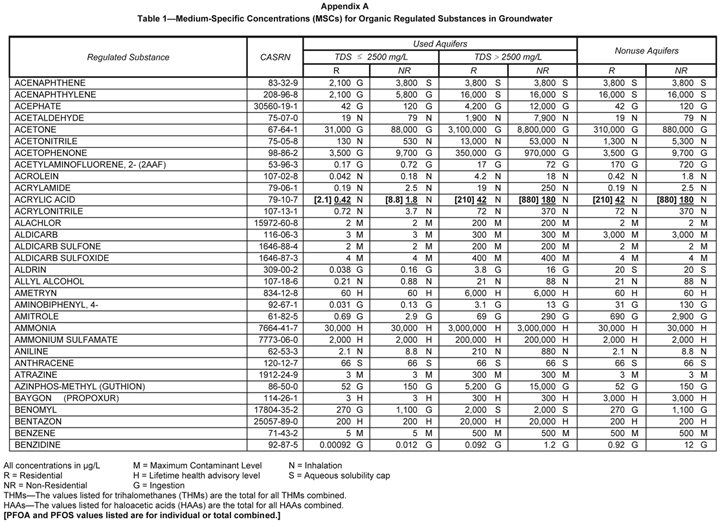




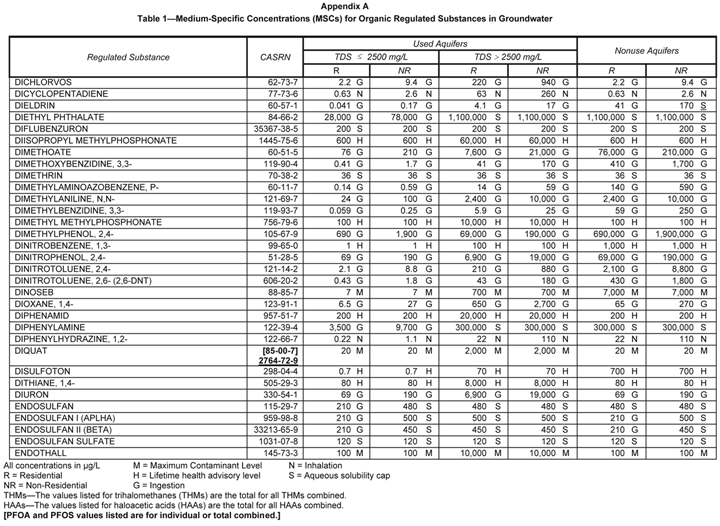
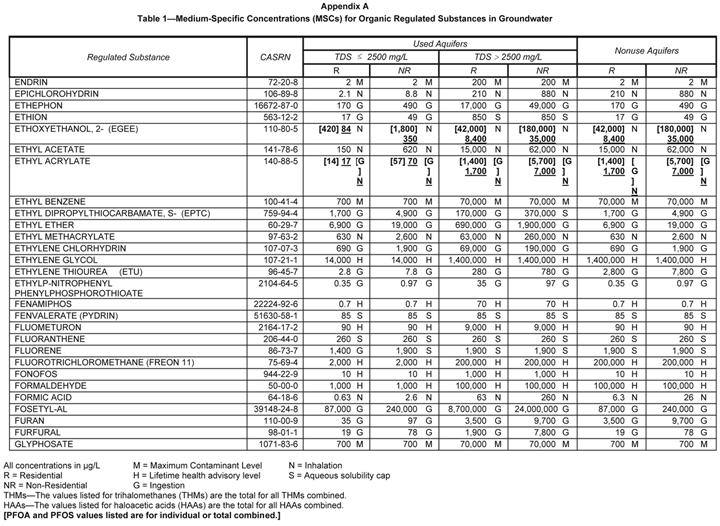
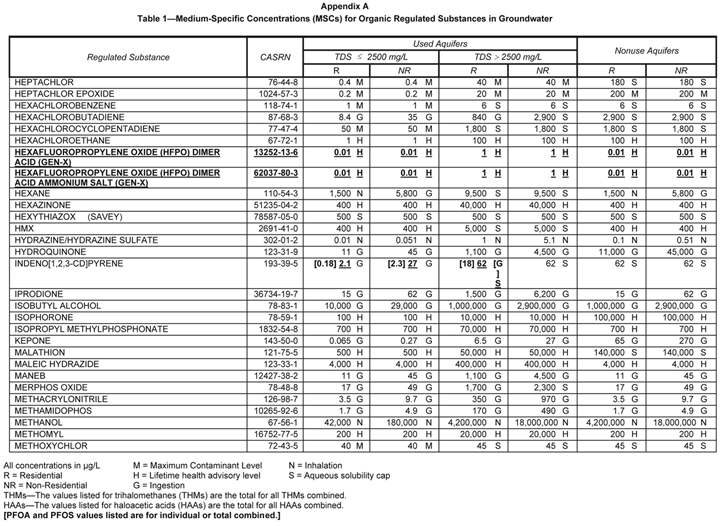
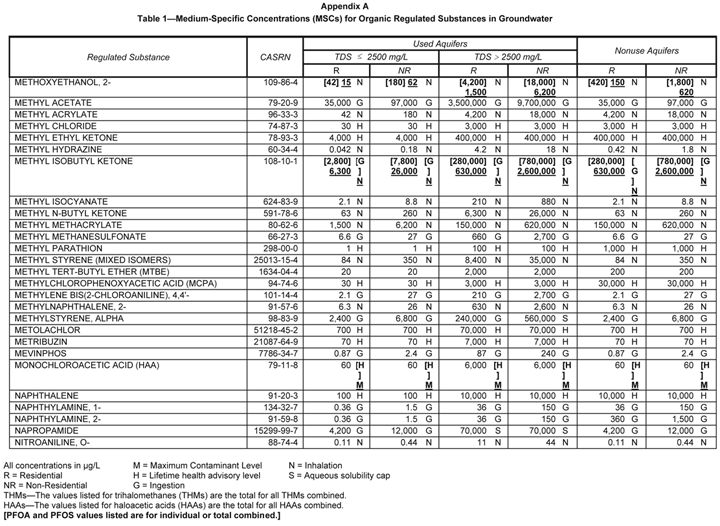
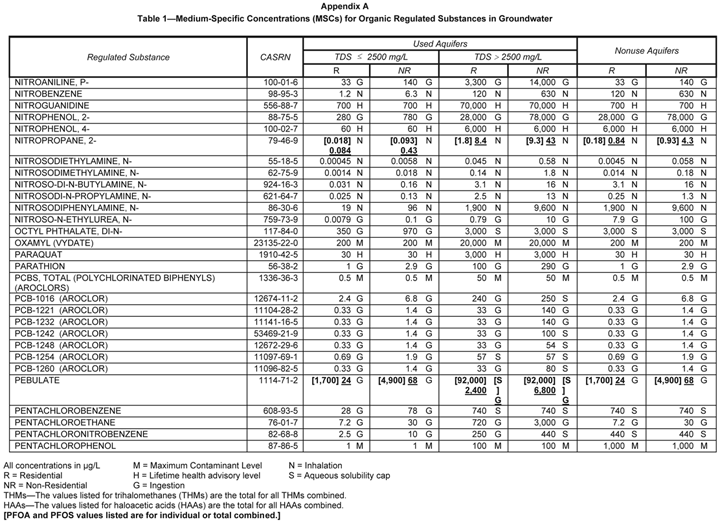
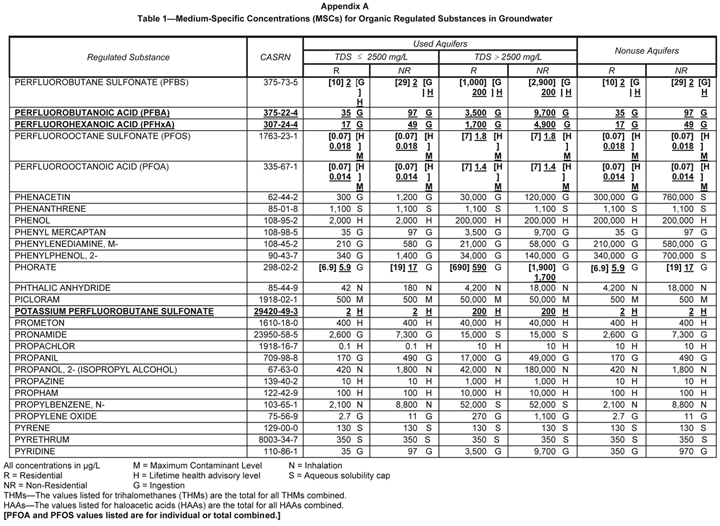
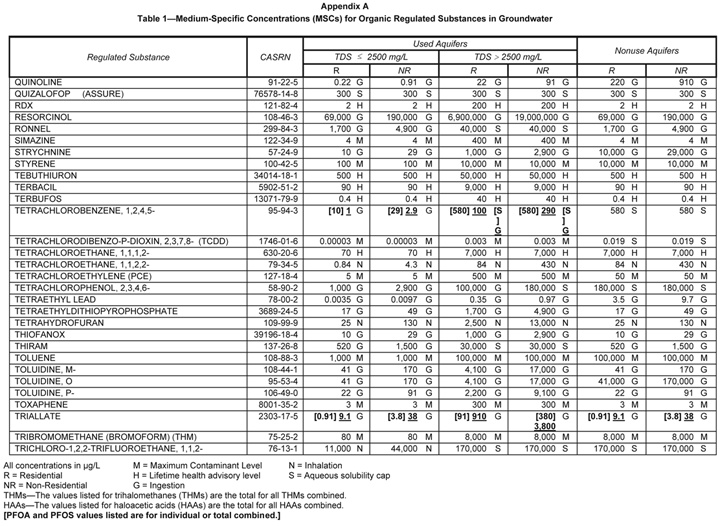
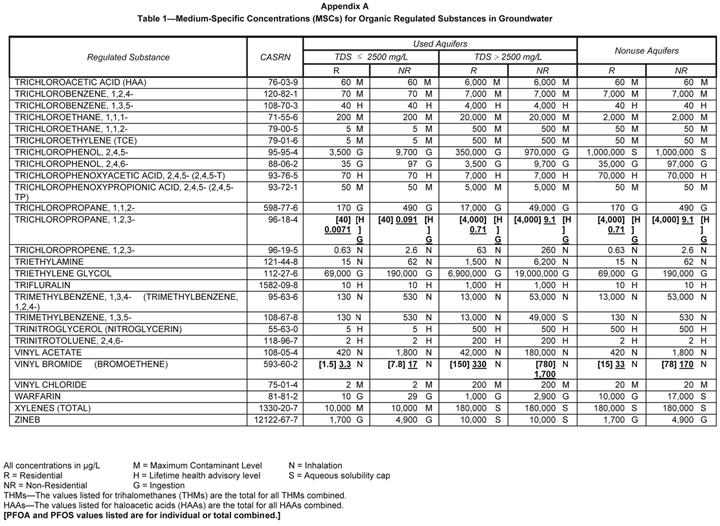
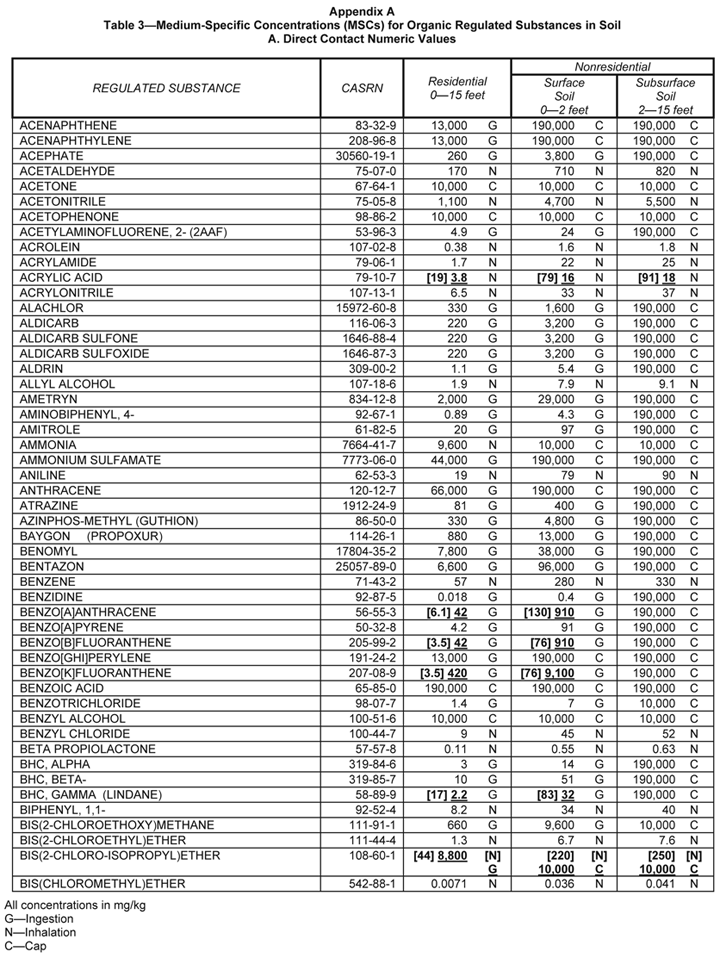
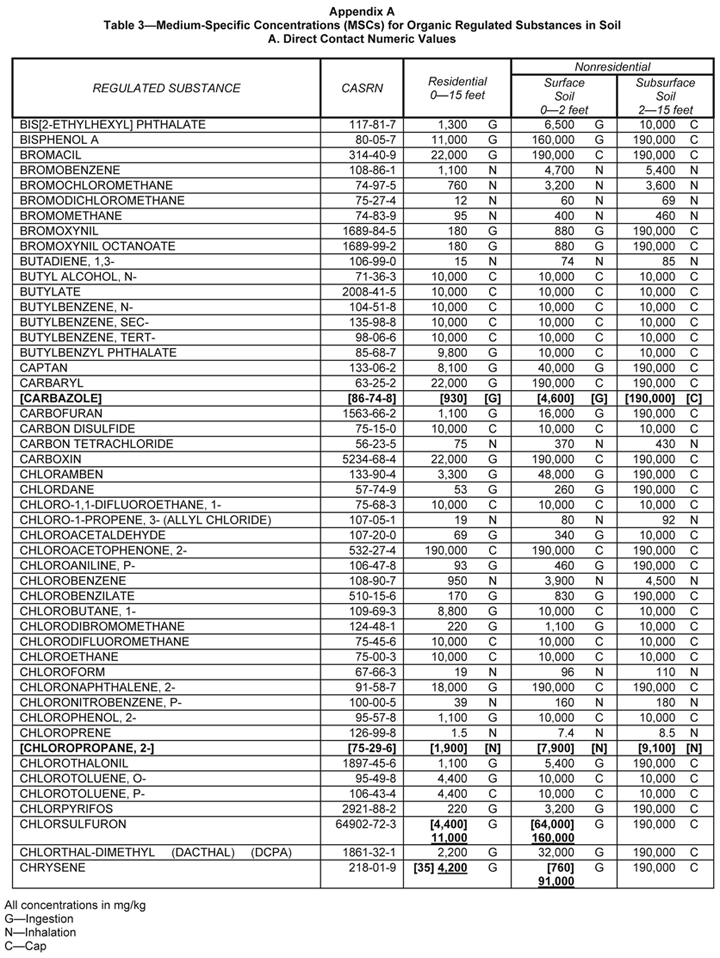
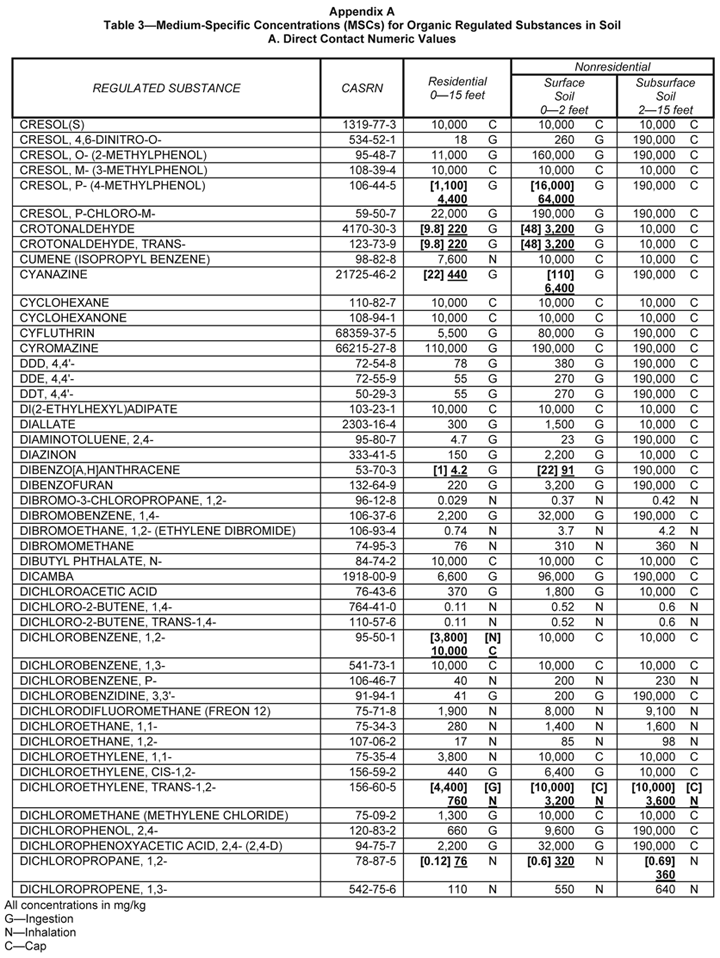
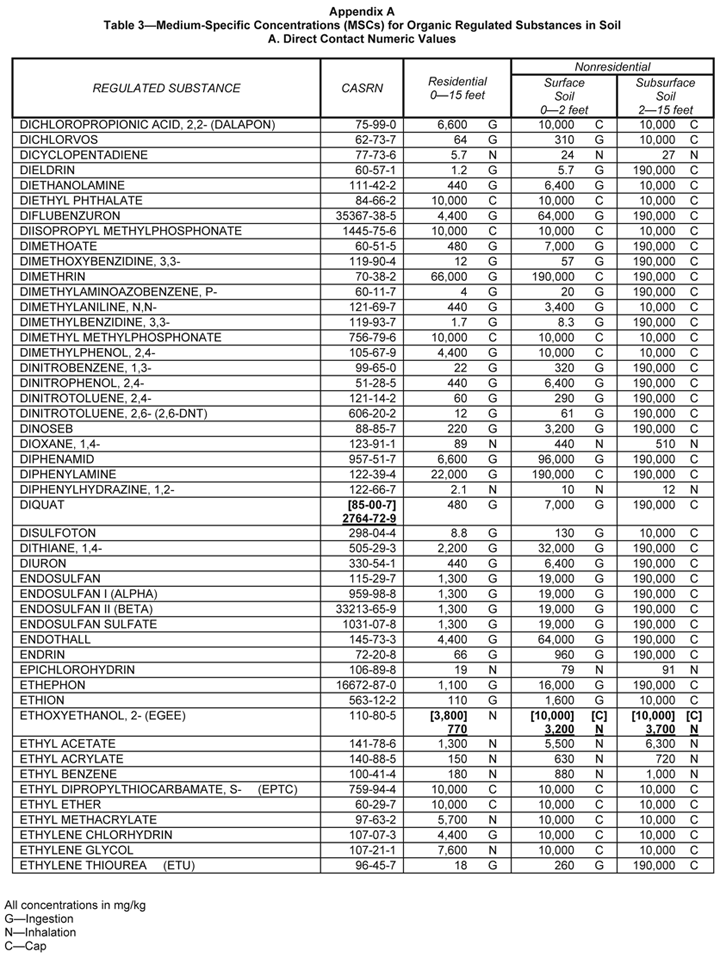
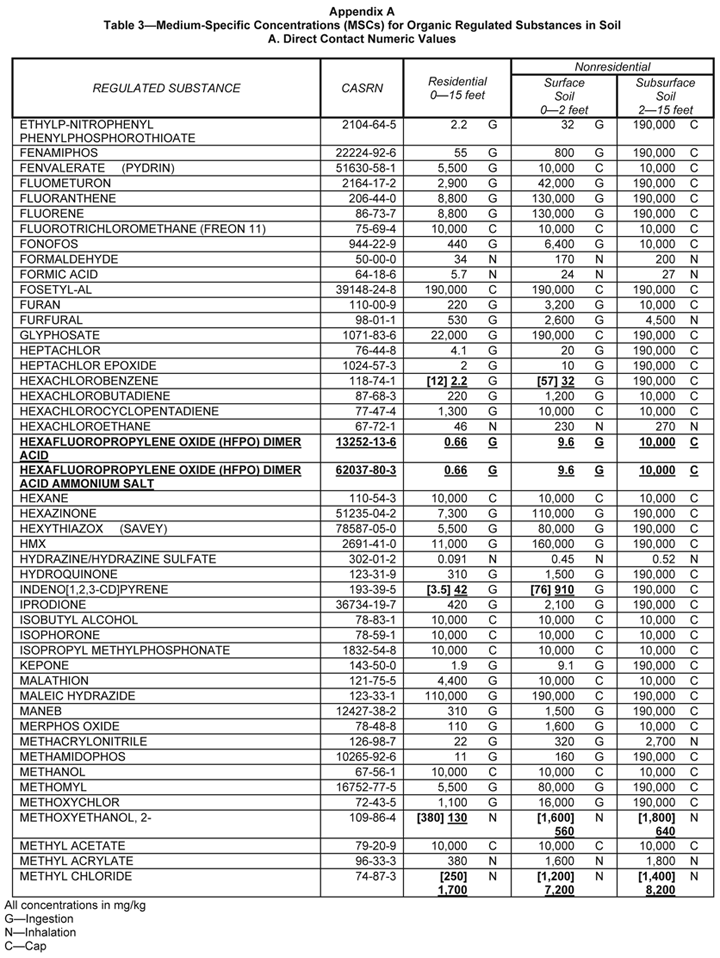
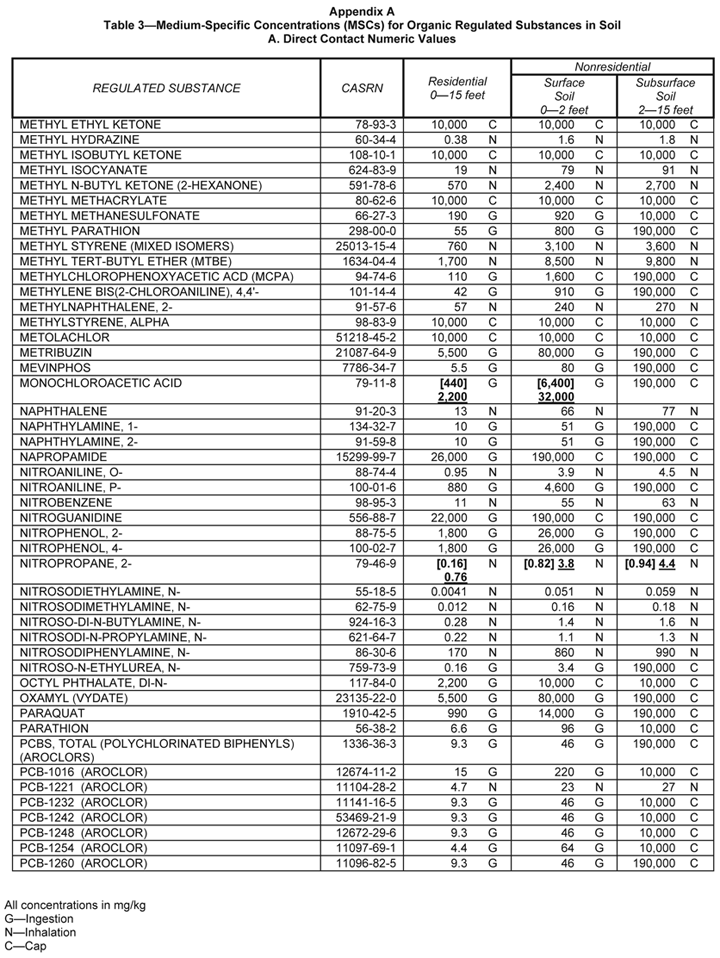
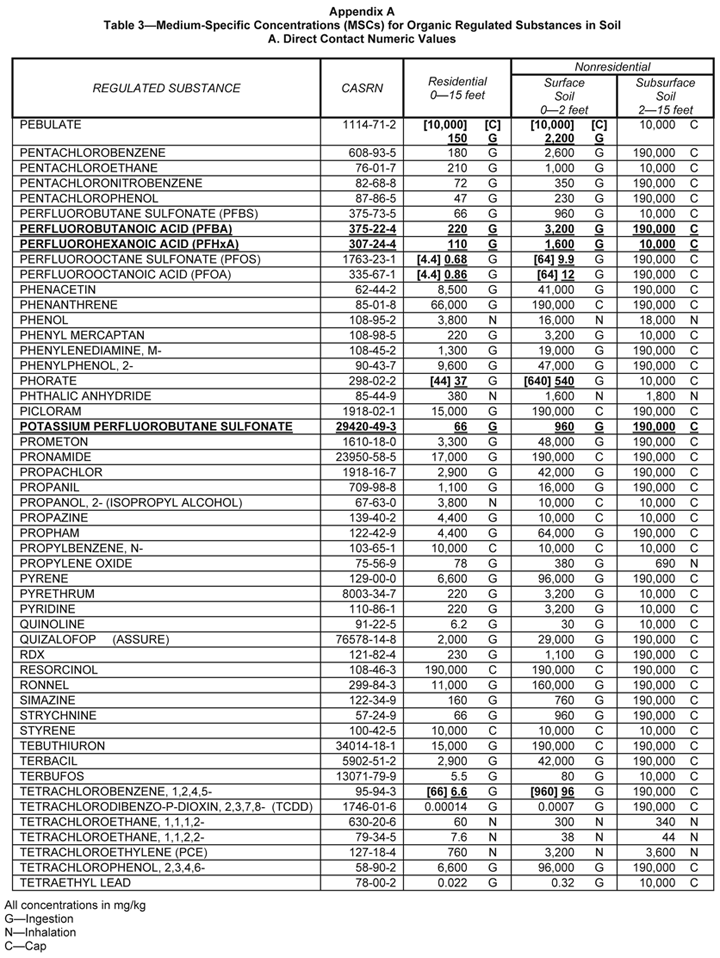
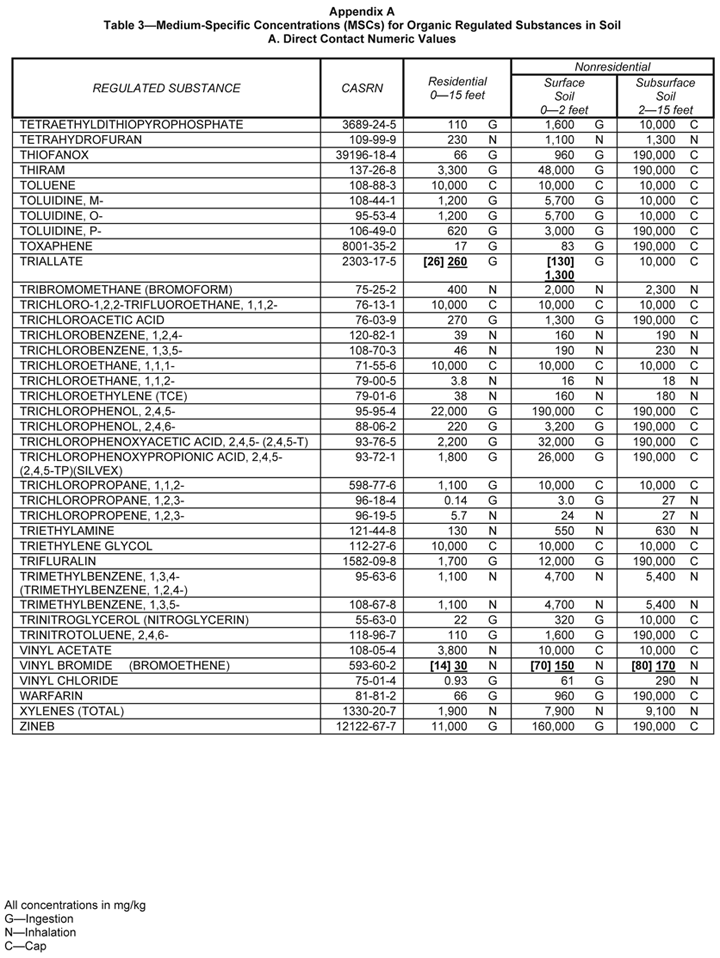
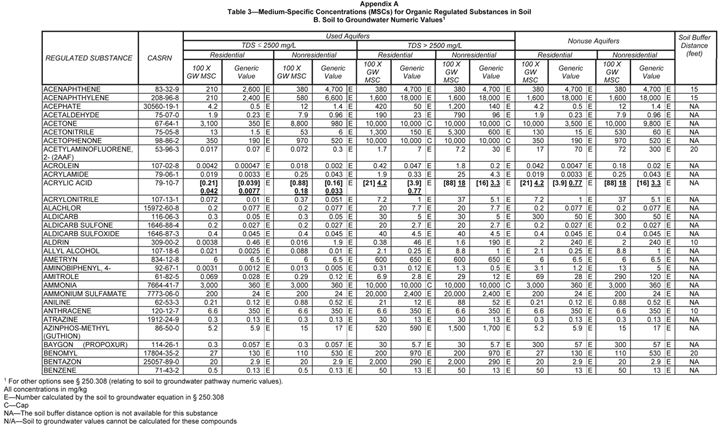
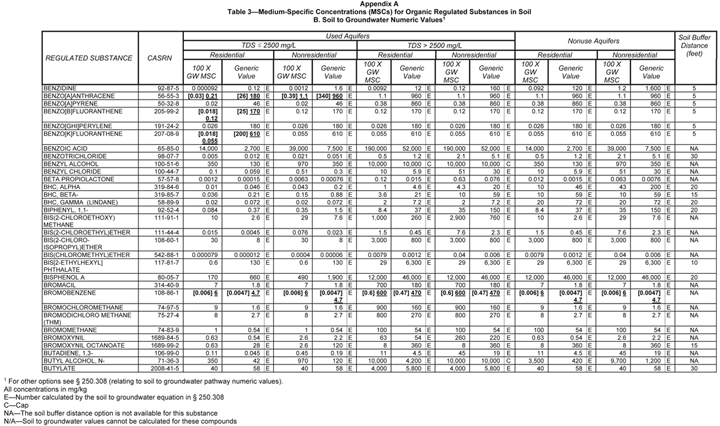
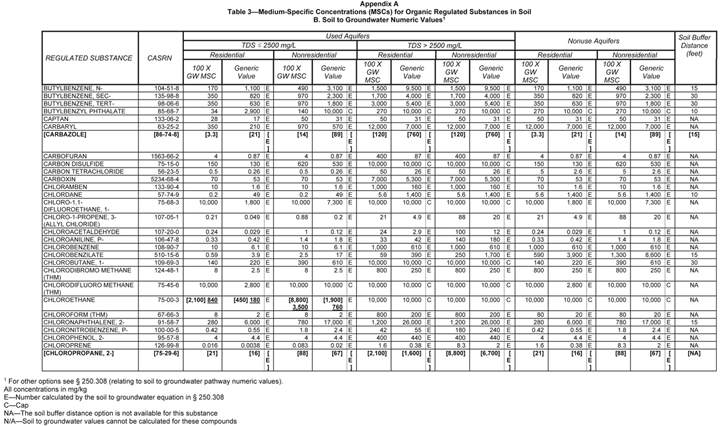
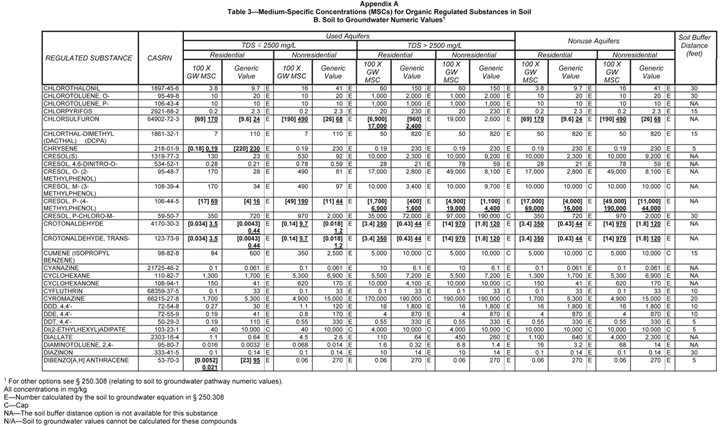



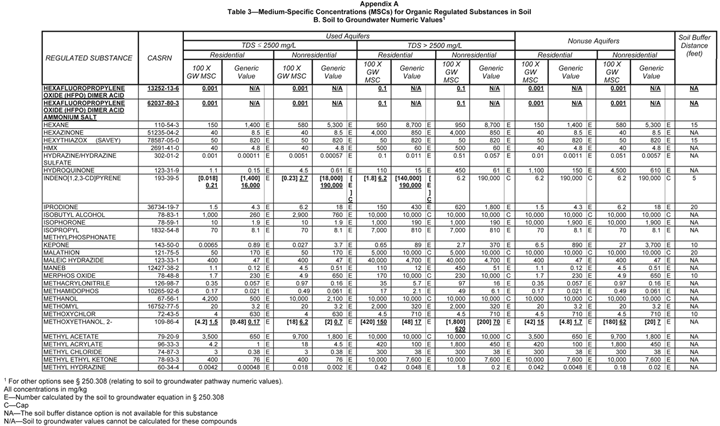
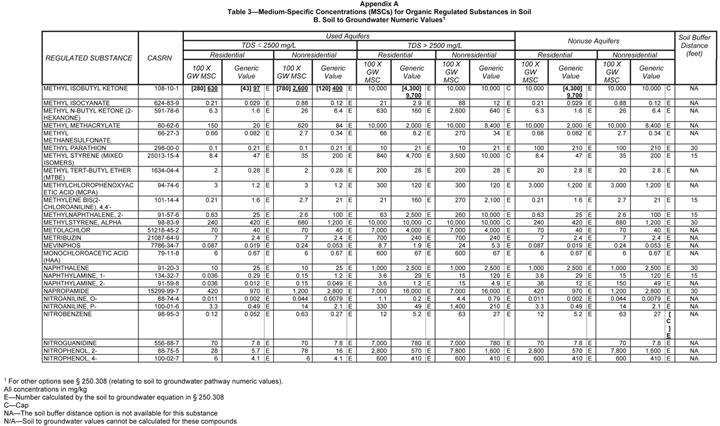
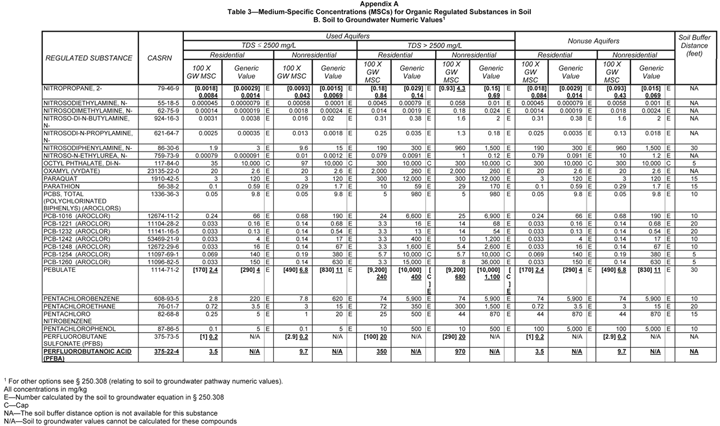
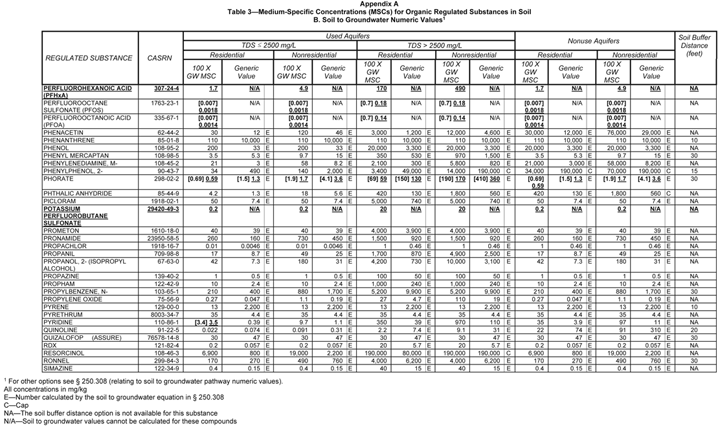
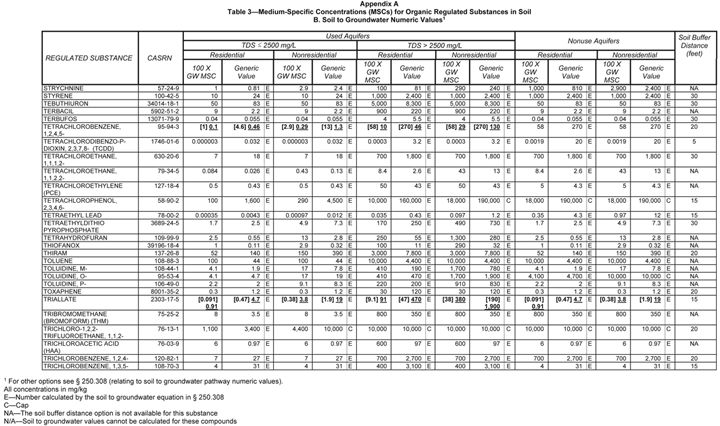
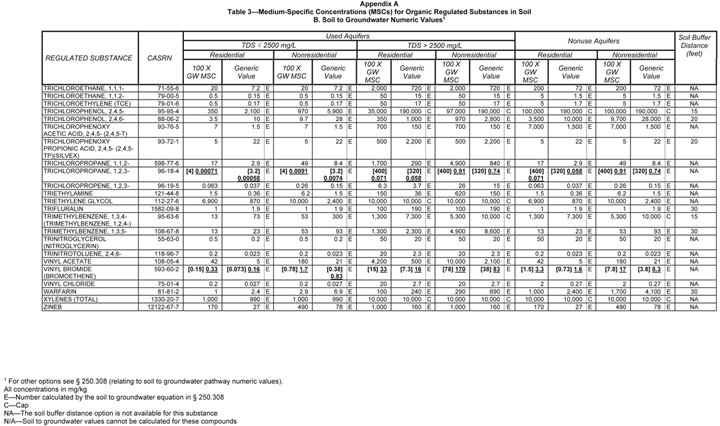
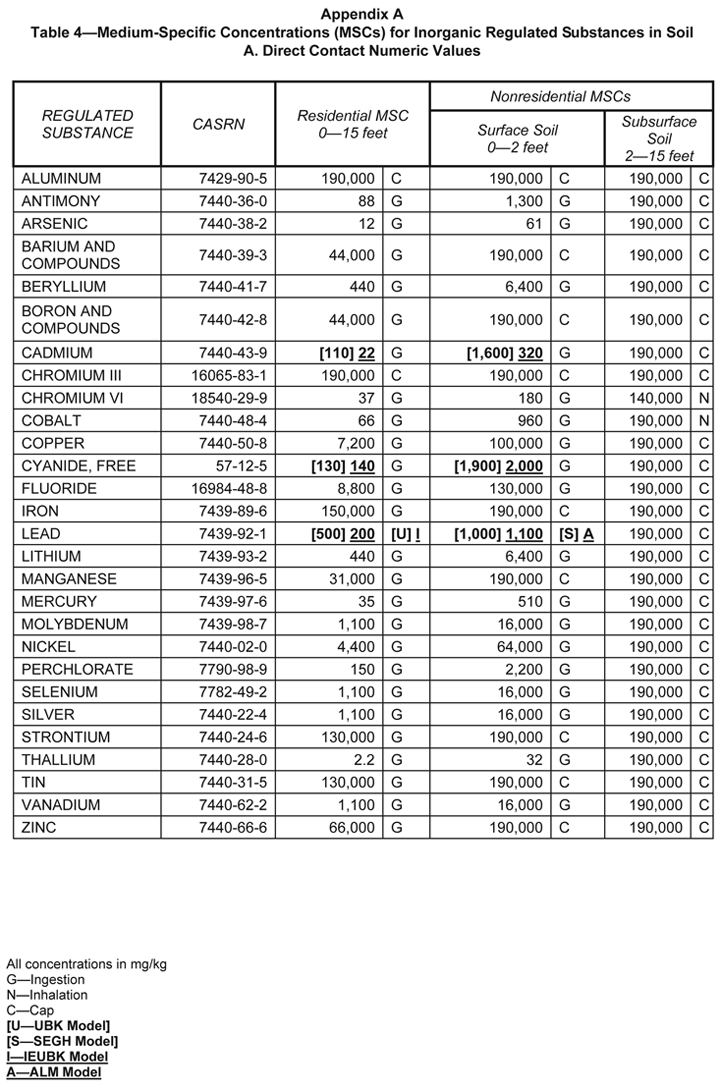
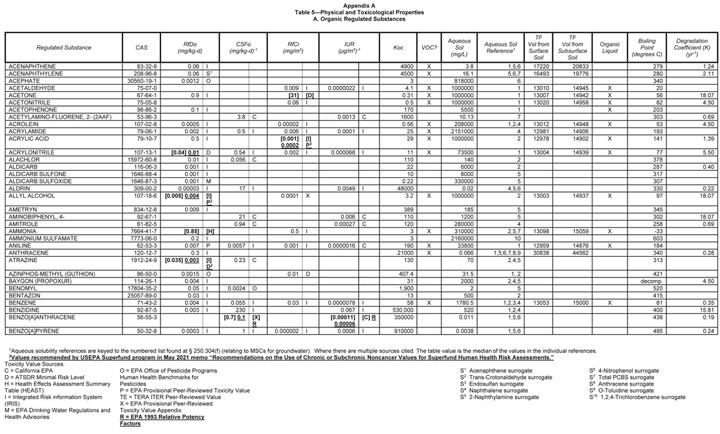
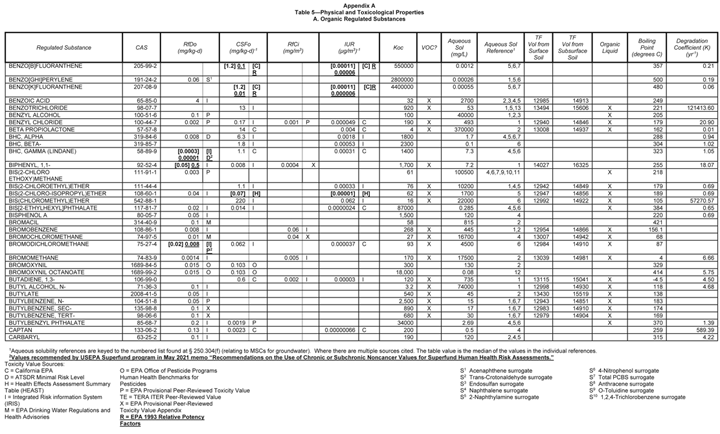
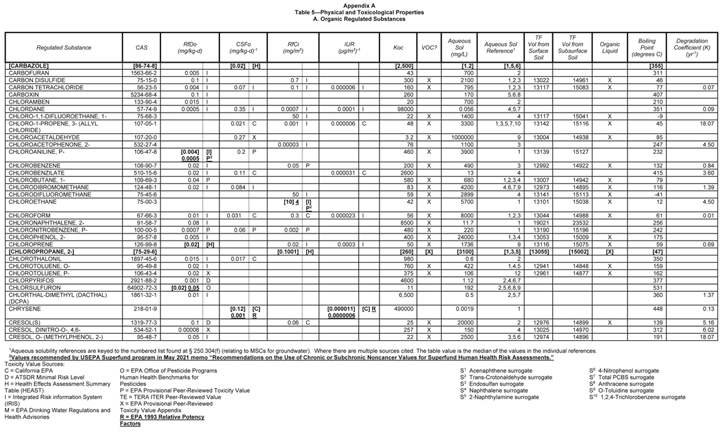
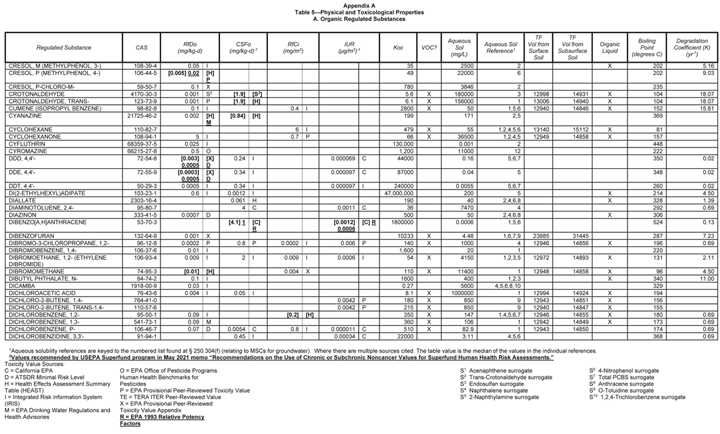
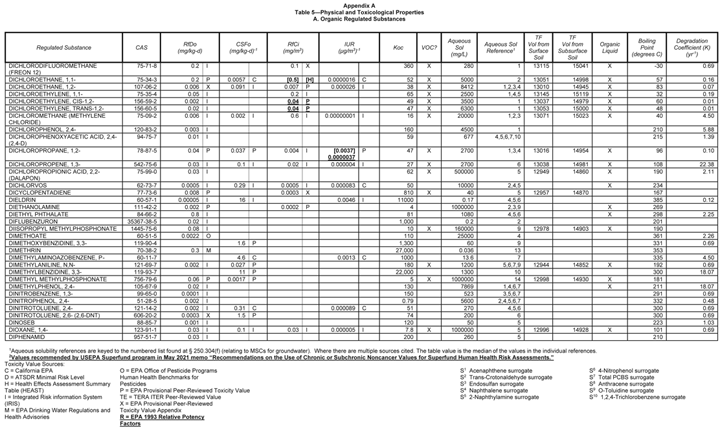

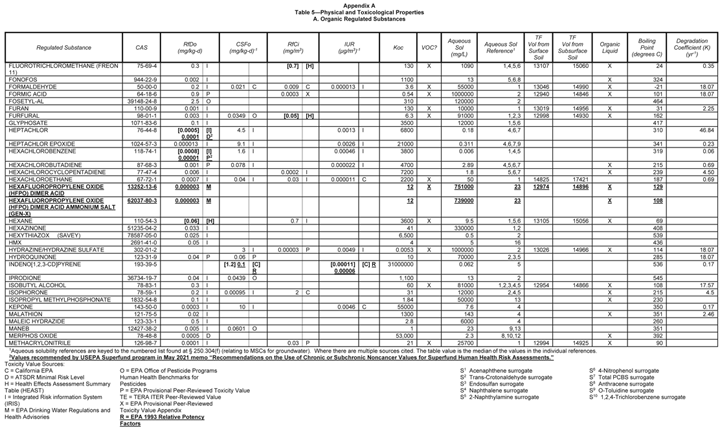
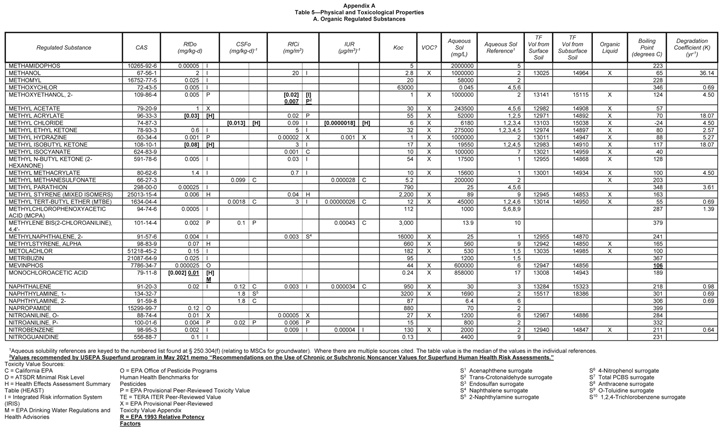

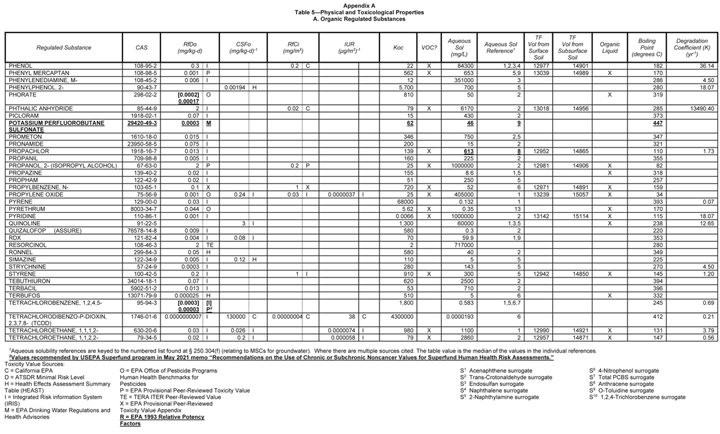
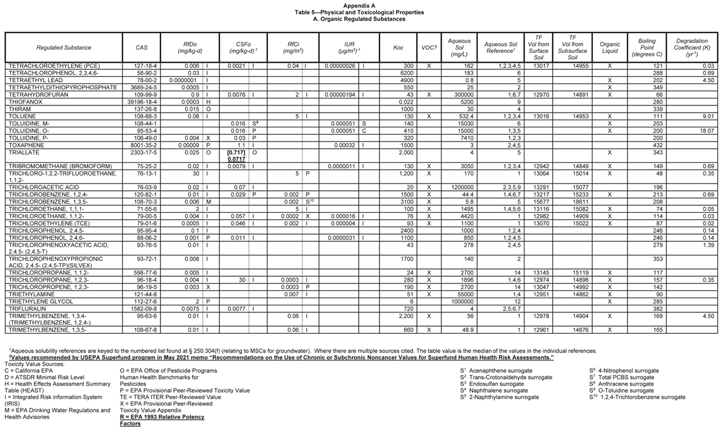
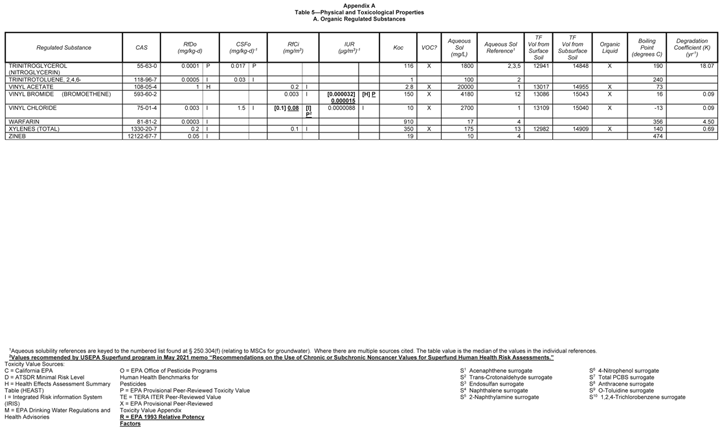
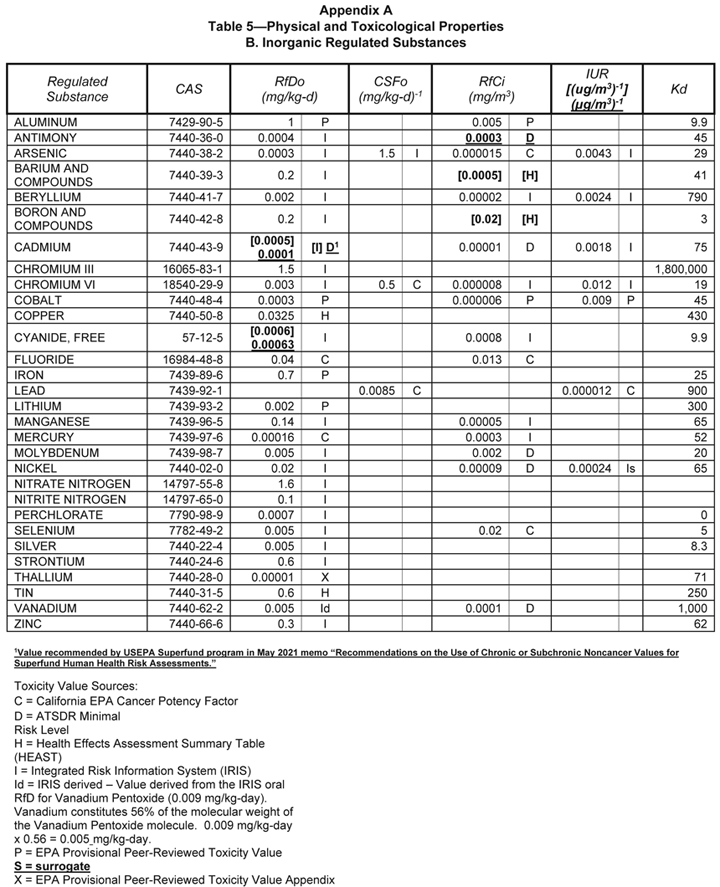
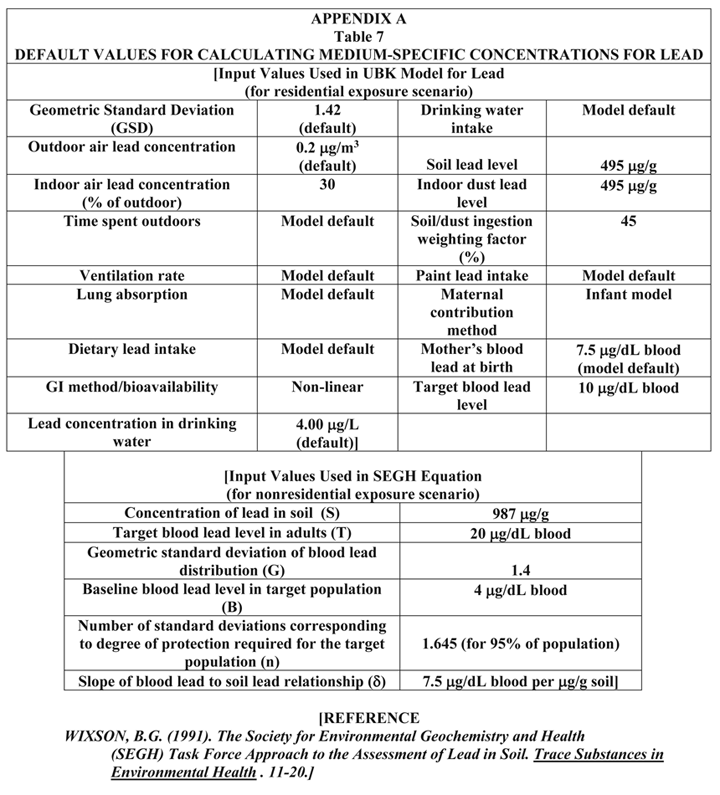
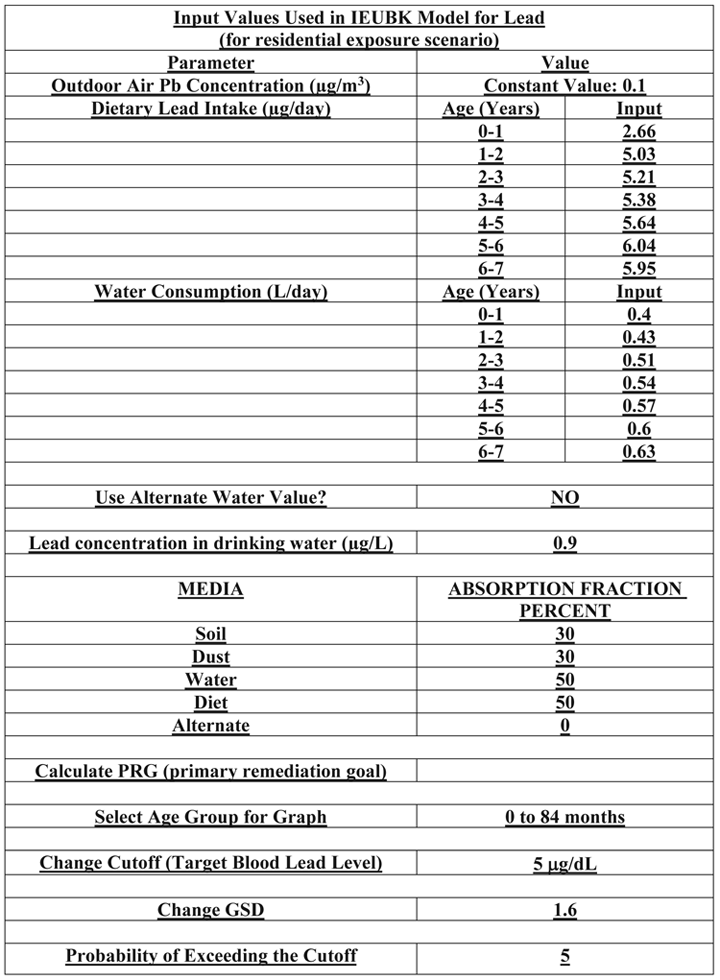
[Pa.B. Doc. No. 24-982. Filed for public inspection July 12, 2024, 9:00 a.m.]
No part of the information on this site may be reproduced for profit or sold for profit.This material has been drawn directly from the official Pennsylvania Bulletin full text database. Due to the limitations of HTML or differences in display capabilities of different browsers, this version may differ slightly from the official printed version.